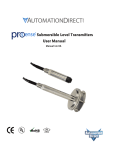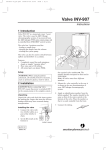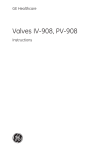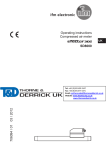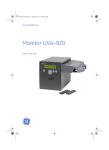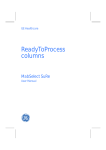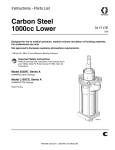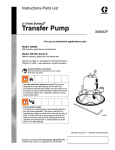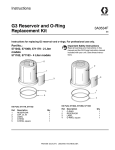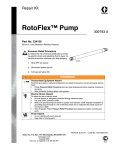Download Hitachi 210-208 User's Manual
Transcript
INSTRUCTIONS-PARTS LIST This manual contains important warnings and information. READ AND KEEP FOR REFERENCE. 308–043 Rev. F Supersedes Rev. C and PCN D INSTRUCTIONS Displacement Pump 1000 psi (70 bar, 7 MPa) Maximum Working Pressure Model 210–208, Series F GRACO INC. P.O. BOX 1441 MINNEAPOLIS, MN COPYRIGHT 1990, GRACO INC. Graco Inc. is registered to I.S. EN ISO 9001 55440–1441 Table of Contents Warnings . . . . . . . . . . . . . . . . . . . . . . . . . . . . . . . . . . . . . . 2 Setup/Operation . . . . . . . . . . . . . . . . . . . . . . . . . . . . . . . 5 Service . . . . . . . . . . . . . . . . . . . . . . . . . . . . . . . . . . . . . . . 6 Parts Drawing and Parts List . . . . . . . . . . . . . . . . . . . . 10 Technical Data . . . . . . . . . . . . . . . . . . . . . . . . . . . . . . . . 11 Warranty . . . . . . . . . . . . . . . . . . . . . . . . . . . . . . . . . . . . . 12 Graco Phone Numbers . . . . . . . . . . . . . . . . . . . . . . . . . 12 Symbols Warning Symbol WARNING This symbol alerts you to the possibility of serious injury or death if you do not follow the instructions. Caution Symbol This symbol alerts you to the possibility of damage to or destruction of equipment if you do not follow the instructions. EQUIPMENT MISUSE HAZARD Equipment misuse can cause the equipment to rupture or malfunction and result in serious injury. D This equipment is for professional use only. D Read all instruction manuals, tags, and labels before operating the equipment. D Use the equipment only for its intended purpose. If you are not sure, call your Graco distributor. D Do not alter or modify this equipment. Use only genuine Graco parts and accessories. D Check equipment daily. Repair or replace worn or damaged parts immediately. D Do not exceed the maximum working pressure stated on the equipment or in the Technical Data for your equipment. Do not exceed the maximum working pressure of the lowest rated component in your system. D Use fluids and solvents which are compatible with the equipment wetted parts. Refer to the Technical Data section of all equipment manuals. Read the fluid and solvent manufacturer’s warnings. D Handle hoses carefully. Do not use hoses to pull equipment. D Route hoses away from traffic areas, sharp edges, moving parts, and hot surfaces. Do not expose Graco hoses to temperatures above 66_C (150_F) or below –40_C (–40_F). D Wear hearing protection when operating this equipment. D Do not lift pressurized equipment. D Comply with all applicable local, state, and national fire, electrical, and safety regulations. INJECTION HAZARD Spray from the gun, leaks or ruptured components can inject fluid into your body and cause extremely serious injury, including the need for amputation. Fluid splashed in the eyes or on the skin can also cause serious injury. D Fluid injected into the skin might look like just a cut, but it is a serious injury. Get immediate medical attention. D Do not point the gun/valve at anyone or at any part of the body. D Do not put your hand or fingers over the spray tip/nozzle. D Do not stop or deflect leaks with your hand, body, glove or rag. D Do not “blow back” fluid; this is not an air spray system. D Always have the tip guard and the trigger guard on the gun when spraying/dispensing. D Be sure the gun trigger safety operates before spraying. D Lock the gun trigger safety when you stop spraying/dispensing. D Follow the Pressure Relief Procedure on page 5 if the spray tip/nozzle clogs and before cleaning, checking or servicing the equipment. D Tighten all fluid connections before operating the equipment. D Check the hoses, tubes, and couplings daily. Replace worn or damaged parts immediately. Do not repair high pressure couplings; you must replace the entire hose. D Fluid hoses must have spring guards on both ends, to help protect them from rupture caused by kinks or bends near the couplings. Moving parts can pinch or amputate your fingers. D Keep clear of all moving parts when starting or operating the pump. D Before checking or servicing the equipment, follow the Pressure Relief Procedure on page 5 to prevent the equipment from starting unexpectedly. FIRE AND EXPLOSION HAZARD Improper grounding, poor ventilation, open flames or sparks can cause a hazardous condition and result in a fire or explosion and serious injury. D Ground the equipment and the object being sprayed. Refer to Grounding on page 5. D If there is any static sparking or you feel an electric shock while using this equipment, stop spraying immediately. Do not use the equipment until you identify and correct the problem. D Provide fresh air ventilation to avoid the buildup of flammable fumes from solvents or the fluid being sprayed. D Keep the spray/dispense area free of debris, including solvent, rags, and gasoline. D Before operating this equipment, electrically disconnect all equipment in the spray/dispense area. D Before operating this equipment, extinguish all open flames or pilot lights in the spray/dispense area. D Do not smoke in the spray/dispense area. D Do not turn on or off any light switch in the spray/dispense area while operating or if fumes are present. D Do not operate a gasoline engine in the spray/dispense area. TOXIC FLUID HAZARD Hazardous fluid or toxic fumes can cause serious injury or death if splashed in the eyes or on the skin, inhaled, or swallowed. D Know the specific hazards of the fluid you are using. D Store hazardous fluid in an approved container. Dispose of hazardous fluid according to all local, state and national guidelines. D Always wear protective eyewear, gloves, clothing and respirator as recommended by the fluid and solvent manufacturer. Setup/Operation General Information NOTE: Reference numbers and letters in parentheses in the text refer to the callouts in the figures and the parts drawing. NOTE: Always use Genuine Graco Parts and Accessories, available from your Graco distributor. Grounding 3. Fluid hoses: use only electrically conductive fluid hoses. 4. Air compressor or hydraulic power supply: follow manufacturer’s recommendations. 5. Spray gun or dispensing valve: ground through connection to a properly grounded fluid hose and pump. 6. Fluid supply container: follow your local code. WARNING FIRE AND EXPLOSION HAZARD Before operating the pump, ground the system as explained below. Also read the section FIRE OR EXPLOSION HAZARD on page 4. 1. Pump: Ground the complete pump as indicated in your separate pump instruction manual. 2. Air hoses: use only electrically conductive air hoses 7. Object being sprayed: follow your local code. 8. Solvent pails used when flushing: follow your local code. Use only metal pails, which are conductive, placed on a grounded surface. Do not place the pail on a nonconductive surface, such as paper or cardboard, which interrupts the grounding continuity. 9. To maintain grounding continuity when flushing or relieving pressure, hold a metal part of the spray gun firmly to the side of a grounded metal pail, then trigger the gun. Operation Pressure Relief Procedure WARNING INJECTION HAZARD The system pressure must be manually relieved to prevent the system from starting or spraying accidentally. Fluid under high pressure can be injected through the skin and cause serious injury. To reduce the risk of an injury from injection, splashing fluid, or moving parts, follow the Pressure Relief Procedure whenever you: D D D D are instructed to relieve the pressure, stop spraying/dispensing, check or service any of the system equipment, or install or clean the spray tips/nozzles. 1. Lock the spray gun/dispensing valve safety latch. 2. Shut off the air or hydraulic supply to the pump. 3. In air-powered systems, close the bleed-type master air valve (required in your system). In hydraulic-powered systems, close the hydraulic supply line valve first, then the return line valve. 4. Unlock the gun/valve trigger safety. 5. Hold a metal part of the gun/valve firmly to the side of a grounded metal pail, and trigger the gun/valve to relieve pressure. 6. Lock the gun/valve trigger safety latch. 7. Open the drain valve (required in your system), having a container ready to catch the drainage. 8. Leave the drain valve open until you are ready to spray/dispense again. If you suspect that the spray tip or hose is completely clogged, or that pressure has not been fully relieved after following the steps above, very slowly loosen the tip guard retaining nut or hose end coupling and relieve pressure gradually, then loosen completely. Now clear the tip or hose. Service Notes D Repair Kit 223–439 is available to service the pump. For the best results, use all the kit parts. Parts included in the kit are marked with an asterisk in the text, for example (15*). D If possible, have all the necessary replacement parts available before you begin the repair, to reduce down time. D When replacing the displacement rod (36) or the cylinder (38), always replace all of the pump packings, seals, and glands, to ensure proper sealing. Disconnecting the Displacement Pump WARNING To reduce the risk of serious injury whenever you are instructed to relieve pressure, always follow the Pressure Relief Procedure on page 5. 1. Solvent flush the pump if possible. Then, relieve the pressure. 2. Disconnect the hoses from the pump. Remove the pump from its mounting and clamp it in a vise. 3. Disconnect the displacement pump from the motor as explained in your separate pump manual. Intake Valve (Fig. 1) 4. Reassemble the valve. Place the ball stop pin (28) in the same holes from which it was removed. If you want to change the fluid flow through the pump, place the pin in a different set of holes. Refer to Check Valve Adjustment. 5. If no further service is needed, reinstall the intake valve on the pump. Torque the hex nuts (13) evenly to 50–60 ft-lb (68–81 NSm), using a crisscross tightening pattern. Piston (Fig. 1) 1. Remove the intake valve as explained in Intake Valve. 2. Pull the cylinder (38) down, off the piston assembly. 3. Unscrew the piston retainer screws (25). Remove the piston parts from the displacement rod (36). 4. Clean all parts thoroughly, and inspect them for wear or damage. Replace parts as needed. 5. Place the gasket (49) and ball (16) on the piston retainer (43). Install these parts in the displacement rod. NOTE: The piston retainer (43) must not obstruct the ports in the displacement rod (36). 6. Install one cup packing (31*) on the displacement rod (36). Be sure the lips of the packing face up. 7. Install the packing spacer (30). Position one cup packing (31*) on the displacement rod so the lips of the packing face down. 1. Remove the hex nuts (13) and washers (14) from the tie rods (32). Unscrew the tie rods from the intake valve (42). Remove the intake valve from the pump. 8. Install the piston guide (35). Install the four screws (25) through the piston assembly and screw them into the displacement rod (36). Torque the screws evenly to 30–40 ft-lb (41–54 NSm), using a crisscross tightening pattern. 2. Disassemble the intake valve. Take note of which set of holes the ball stop pin (28) is in. 9. If no further service is needed, go to Throat Packings. If no further service is needed, slide the cylinder (38) and gaskets (24*) over the piston assembly. Install the intake valve. Torque the nuts (13) evenly to 50–60 ft-lb (68–81 NSm). 3. Clean all parts thoroughly, and inspect them for wear or damage. Replace parts as needed. Service 1 Lower Holes 4 Lips of V-packings must face down 2 Torque to 50–60 ft-lb (68–81 NSm) 5 Torque to 30–40 ft-lb (41–54 NSm) 3 Tighten in a criss-cross pattern THROAT 39 39 47 3 2 13 14 4 41 24* 45* 4 *46 *44 32 36 38 41 1 PISTON 36 28 1 18** *15 28 †16 49 43 *15 42 *31 30 *31 35 3 5 25 06644 Fig. 1 Service Throat Packings (Fig. 1) 1. Remove the intake valve and the cylinder (38) as explained in the previous sections. 2. Remove the packing nut/wet-cup (39). 3. Pull the displacement rod (36) out of the bottom of the outlet housing (41). 4. Remove the throat packings and glands from the outlet housing. 5. Clean all parts thoroughly, and inspect them for wear or damage. Replace parts as needed. NOTE: Always replace the male gland (44) and the bearing (47) when the throat packings are replaced. 6. Install the throat packings into the outlet housing (41) one at a time in the following order, with the lips of the v-packings facing down: the male gland (44*), two UHMWPE v-packings (45*), one leather v-packing (46*), one UHMWPE v-packing (45*), one leather v-packing (46*), one UHMWPE v-packing (45*), and the bearing (47). Loosely install the packing nut/wet-cup (39). 7. Push the displacement rod (36) up into the outlet housing (41) until it protrudes from the packing nut/wet-cup (39). Continue reassembling the pump in the reverse order of disassembly. Tighten the packing nut/wet-cup just tight enough to prevent leakage. Reconnecting the Displacement Pump 1. Reinstall the displacement pump on the motor as explained in your separate pump manual. 2. Reconnect the ground wire to the motor. Check Valve Adjustment The fluid piston and intake valves are factory-set for high-volume pumping of heavy, spray-viscosity fluids. For lighter fluids or lower volume requirements, or to reduce surging at the stroke change-over, decrease the travel of the balls (16 and 18). Move the pins (28) to a lower set of holes. See Fig. 1 and refer to the pump disassembly procedure above. NOTE: If the ball travel is too short for the fluid being pumped, the fluid flow will be restricted. For heavier fluids or to increase the flow, increase the travel of the balls (16 and 18). Move the pins (28) to a higher set of holes. See Fig. 1 and refer to your pump disassembly procedure above. Notes Parts 39 36 *24 †47 15 38 16† *45 49 28 *46 43 24* 32 31* 15* †18 30 44* 13 14 41 31* 42 28 35 25 32 06645 Parts Model 210–208, Series F Displacement Pump Includes items 13–49 Ref No. Part No. 13 14 15* 16† 100–127 100–128 100–579 101–178 18† 101–718 24* 25 111–334 104–272 28 30 31* 32 35 36 38 39 161–599 166–597 188–846 171–692 171–696 217–478 181–269 186–054 41 42 186–055 223–437 43 223–438 44* 45* 46* 47† 48 49 104–260 108–845 104–263 186–056 172–477 110–728 Description Packing Conversion Kit 224–443 Use to convert pump to UHMWPE and PTFE packings. Order kit separately. Includes: Qty. NUT, hex; 5/8–11 LOCKWASHER, spring; 5/8” PIN, cotter; 1” (25.4 mm) long BALL; 1.25” (32 mm) dia.; chrome steel BALL; 2” (51 mm) dia.; chrome steel O-RING. PTFE CAPSCREW, socket hd; 3/8–24 x 1–1/2” (38 mm) long PIN, ball stop; carbon steel SPACER, packing, carbon steel PACKING, cup; UHMWPE ROD, tie GUIDE, piston; carbon steel ROD, displacement; carbon steel CYLINDER, stainless steel PACKING NUT/WET–CUP carbon steel HOUSING, outlet; ductile iron HOUSING, intake valve; carbon steel RETAINER, piston; carbon steel, with carbide seat GLAND, male; carbon steel V-PACKING; UHMWPE V-PACKING; leather BEARING; PEEK TAG, warning GASKET; buna–N 4 4 4 1 1 2 4 2 1 2 4 1 1 1 1 1 Part No. Description 100–103 100–579 111–334 188–846 104–260 108–845 111–327 186–056 PIN, cotter; 15.” (38 mm) long PIN, cotter; 1” (25.4 mm) long O-RING; PTFE PACKING, cup; UHMWPE GLAND, male V-PACKING; UHMWPE V-PACKING; PTFE BEARING, PEEK Qty Technical Data Maximum Fluid Working Pressure . . . . . . . . . 1000 psi (70 bar, 7.0 MPa) Fluid Outlet Size . . . . . . . . . . . . . . . . . . . . . . . 1–1/2” npt Fluid Inlet Size . . . . . . . . . . . . . . . . . . . . . . . . . . . . . 2” npt Wetted Parts . . . . . . . . . . . . 303 Grade Stainless Steel, Carbon Steel, Chrome Steel, Chrome, Zinc, and electroless Nickel Plating, Buna-N, Tungsten Carbide, Nylon, Ultra-High Molecular Weight Polyethylene, Leather, PTFE , Polyetheretherketone 1 1 1 4 2 1 1 1 Manual Change Summary * Included in Repair Kit 223–439. Assembly Changed Part Status Ref. No. Part No. Name ** Recommended spare parts. Keep these spare parts on hand to reduce down-time. 210–208 old new 31 31 178–507 188–846 packing cup packing cup Extra warnings available at no charge. 1 4 2 2 1 4 2 1 The series of this unit was changed from E to F. The Graco Warranty and Disclaimers WARRANTY Graco warrants all equipment listed in this manual which is manufactured by Graco and bearing its name to be free from defects in material and workmanship on the date of sale by an authorized Graco distributor to the original purchaser for use. Graco will, for a period of twelve months from the date of sale, repair or replace any part of the equipment determined by Graco to be defective. This warranty applies only when the equipment is installed, operated and maintained in accordance with Graco’s written recommendations. This warranty does not cover, and Graco shall not be liable for general wear and tear, or any malfunction, damage or wear caused by faulty installation, misapplication, abrasion, corrosion, inadequate or improper maintenance, negligence, accident, tampering, or substitution of non-Graco component parts. Nor shall Graco be liable for malfunction, damage or wear caused by the incompatibility of Graco equipment with structures, accessories, equipment or materials not supplied by Graco, or the improper design, manufacture, installation, operation or maintenance of structures, accessories, equipment or materials not supplied by Graco. This warranty is conditioned upon the prepaid return of the equipment claimed to be defective to an authorized Graco distributor for verification of the claimed defect. If the claimed defect is verified, Graco will repair or replace free of charge any defective parts. The equipment will be returned to the original purchaser transportation prepaid. If inspection of the equipment does not disclose any defect in material or workmanship, repairs will be made at a reasonable charge, which charges may include the costs of parts, labor, and transportation. THIS WARRANTY IS EXCLUSIVE, AND IS IN LIEU OF ANY OTHER WARRANTIES, EXPRESS OR IMPLIED, INCLUDING BUT NOT LIMITED TO WARRANTY OF MERCHANTABILITY OR WARRANTY OF FITNESS FOR A PARTICULAR PURPOSE. Graco’s sole obligation and buyer’s sole remedy for any breach of warranty shall be as set forth above. The buyer agrees that no other remedy (including, but not limited to, incidental or consequential damages for lost profits, lost sales, injury to person or property, or any other incidental or consequential loss) shall be available. Any action for breach of warranty must be brought within two (2) years of the date of sale. GRACO MAKES NO WARRANTY, AND DISCLAIMS ALL IMPLIED WARRANTIES OF MERCHANTABILITY AND FITNESS FOR A PARTICULAR PURPOSE IN CONNECTION WITH ACCESSORIES, EQUIPMENT, MATERIALS, OR COMPONENTS SOLD BUT NOT MANUFACTURED BY GRACO. These items sold, but not manufactured by Graco (such as electric motors, switches, hose, etc.) are subject to the warranty, if any, of their manufacturer. Graco will provide purchaser with reasonable assistance in making any claim for breach of these warranties. For Sales to Canadian Customers: Except as expressly stated herein, Graco makers no representations, warranties or conditions, express, implied or collateral, concerning any goods or services sold, and GRACO SHALL NOT BE LIABLE IN ANY MANNER FOR any other representation, warranty or condition of any kind, whether arising by operation of law or otherwise, including but not limited to, WARRANTIES OF MERCHANTABLE QUALITY OR FITNESS FOR A PARTICULAR PURPOSE. LIMITATION OF LIABILITY In no event will Graco be liable for indirect, incidental, special or consequential damages resulting from Graco supplying equipment hereunder, or for the furnishing, performance, or use of any products or other goods sold hereto, whether due to a breach of contract, breach of warranty, the negligence of Graco, or otherwise. Graco Phone Number TO PLACE AN ORDER, contact your Graco distributor, or call this number to identify the distributor closest to you: 1–800–367–4023 Toll Free All written and visual data contained in this document reflects the latest product information available at the time of publication. Graco reserves the right to make changes at any time without notice. Sales Offices: Atlanta, Chicago, Detroit, Los Angeles Foreign Offices: Belgium, Canada, England, Korea, Switzerland, France, Germany, Hong Kong, Japan GRACO INC. P.O. BOX 1441 MINNEAPOLIS, MN 55440–1441 PRINTED IN U.S.A. 308–043 May, 1990 Revised August 1996












